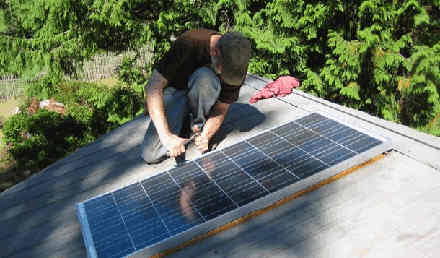
Dipping into off-grid waters
In 2008 a power failure lasted a week at J.D’s former home in remote Arizona. While he had his own well, it was controlled by a pump that required electricity, and the surface of the water was too low to dip some out by hand. Then there was the issue of modern plumbing without electricity, and the requirements of coffee pots to consider. However, outages were common – so J.D had come prepared. He and his wife Wendy Wendy had stored water, cut firewood, and fueled up the camping stove and lanterns. They remained hydrated, warm and fed through that and every other experience with the electric grid’s unreliability.
“All in all, it was a bit Little House on the Prairie for our tastes, though with a better wine selection – but ultimately more of an inconvenience than a disaster,” he wrote. “But tolerance for inconvenience can decline with the years.”
When they moved to a new house in the foothills, Wendy had a strict requirement – a climate-controlled environment in the house at all times. This required some research into the best off-grid power systems to use for the climate, so J.D had to get serious.
“This being Arizona, where everything bakes for much of the year under the fireball in the sky, my first thought was solar,” J.D writes. “But I quickly discovered that all of those panels adorning people’s roofs were nothing more than expensive shingles during a power outage. Most solar installations are designed to feed the grid, not keep you independent of it. I priced adding batteries to the mix to gain some autonomy, but they more than doubled the cost. And batteries couldn’t handle the power demands of an air conditioner anyway. So we settled, if that’s the right word, for a 22 kW standby generator, which can handle the well pump and keep the air conditioning running.”
He said they were “especially pleased” with the decision when the European Union completed a coordinated cyber-attack simulation and found it leading to a “very dark scenario,” including crashed power grids.
J.D also beefed up the water storage capabilities at the house with rain barrels hooked to the gutters, which are conveniently located near the garden where he now grows tomatoes, olive and fig trees.
“Wendy and I have stumbled down our path incrementally over the years out of a combination of necessity and curiosity,” he writes. “We also keep tweaking our set-up. In addition to the generator, I’m putting together a smaller-scale solar power system. That fireball in the sky isn’t going anywhere, and I want to get some use from the thing. I’m picking up a few panels, a few batteries. I doubt I’ll manage to put together a system that can handle the well pump, let alone the air conditioner, but maybe we’ll be able to power a refrigerator. We can always stick our heads in there to cool off in a pinch.”
DIY learning
In a similar long-term learning curve, Eartheasy founder and blogger Greg Seaman has been documenting his many “hits and misses” with off-grid issues such as lighting, electricity and solar panels since 2000. A seasoned off-gridder – he first moved to a rural island in the Pacific Northwest when he was 30 – he has spent more than 30 years learning the art of living off the grid, and writes that it’s a constantly changing and upgrading process. With the added necessity of internet connectivity to maintain his Eartheasy website, and provide access for his family as they grew, he had to develop alternative ways of powering his home.
“Bringing some of the benefits of electrical power to our off-grid home has been a hit-or-miss affair,” he wrote in 2012. “Over the years, we’ve tried some very simple approaches to lighting and small battery recharging for our flashlights, such as hauling a 12 volt car battery to a small rural school about a half mile away every time it needed to be topped up. This was time consuming and inefficient. But we didn’t want to lose the feel of our simple home by bringing in a large generator and the jugs of gas needed to run it, and the prospect of setting up a wind turbine or solar array seemed expensive and a technological eyesore in a natural setting.”
Greg said that for many years the family got along without electricity, but when wireless broadband was introduced into the area, the family decided to build its own “reliable, affordable and do-it-yourself alternative energy system.”
“Today, with the help of a local expert on off-grid home solar power and alternative energy systems, we have the best of both worlds,” he wrote.
Greg, who today runs a successful family business devoted to creating sustainable products for low-impact living, acknowledges that off-grid living isn’t for everyone – the reality of living through the winter, the isolation, physical work, school or community character doesn’t always fit for some people – but if you’re willing to keep learning and trying things yourself, independent homesteading can be a dream come true.